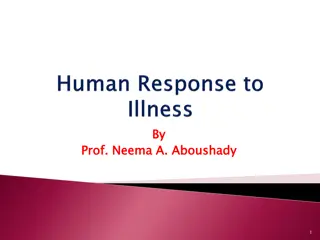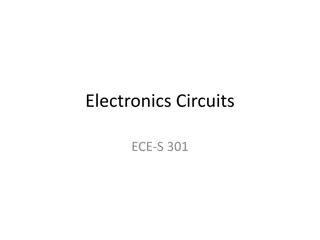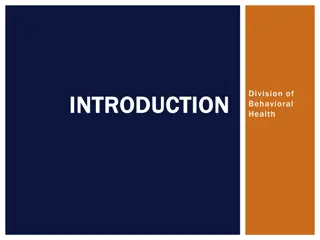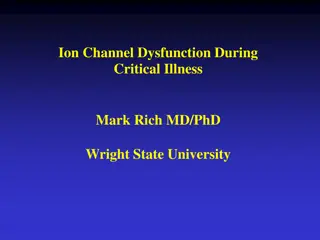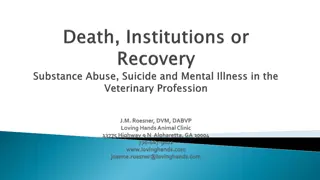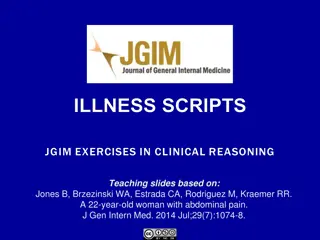
Comparison of Standalone vs. Multistage Critical Illness Cover
Delve into the nuances of Standalone Critical Illness Cover (SCI) and Multistage Critical Illness Cover (MCI) in the Indian actuarial landscape. Uncover the history, customer needs, product variants, pricing, and stakeholder preferences for each type of critical illness insurance. Understand the origins of critical illness insurance, the qualifying conditions, and the basics of critical illness coverage. Differentiate between SCI, which pays a lump sum benefit independent of illness severity, and MCI, which offers multiple benefit payouts linked to disease severity and continues until the entire sum insured is paid out. Explore the reasons behind the introduction of critical illness insurance and its significance in transferring financial risks from individuals to insurance companies.
Download Presentation

Please find below an Image/Link to download the presentation.
The content on the website is provided AS IS for your information and personal use only. It may not be sold, licensed, or shared on other websites without obtaining consent from the author. If you encounter any issues during the download, it is possible that the publisher has removed the file from their server.
You are allowed to download the files provided on this website for personal or commercial use, subject to the condition that they are used lawfully. All files are the property of their respective owners.
The content on the website is provided AS IS for your information and personal use only. It may not be sold, licensed, or shared on other websites without obtaining consent from the author.
E N D
Presentation Transcript
27th India Fellowship Seminar Standalone critical illness cover V/s. Multistage critical illness Prepared by: DHARMENDER KUMAR SHRIVASTAVA K SANDHYA SEEMA MALI DNKLNK CHAKRAVARTHI Reviewed by: IRVINDER SINGH KOHLI Date: 1st & 2nd June 2017 Place : Mumbai Indian Actuarial Profession Serving the Cause of Public Interest
AGENDA History of CI risk and Terrorism risk - Challenges in pricing Regulation & Taxation Stand Alone CI(SCI) and Multistage CI(MCI) Customer Needs Variants of MCI Product Design & Pricing of MCI Various stakeholders preferences ConclusionFI Indian Actuarial Profession Serving the Cause of Public Interest
History of CI & IRDAI Regulations Indian Actuarial Profession Serving the Cause of Public Interest
Origin of CI Concept of CI was introduced by doctor not an insurance company In 1983, along with the help of a South African insurance company called Crusader Life, Dr. Marius Barnard introduced critical illness insurance to the market CI included - Cancer, heart attack, stroke and coronary bypass surgery Provided a way for people to transfer the financial risk of a critical illness from themselves to an insurance company Indian Actuarial Profession Serving the Cause of Public Interest
Basics of CI Provides benefits upon the diagnosis and survival of one of the specific illnesses specified in the policy terms & conditions Life threatening or lifestyle threatening Qualifying Conditions 1. Perceived to be dangerous 2. Not rare 3. Adequate data for pricing Indian Actuarial Profession Serving the Cause of Public Interest
Standalone Critical Illness Cover (SCI) Pays lump sum benefit Independent of the severity of the illness Cover terminates on payment of the benefit Generally no benefit on death Indian Actuarial Profession Serving the Cause of Public Interest
Multi-stage Critical Illness Cover (MCI) Pay benefit multiple times Benefit pay-out linked to severity of illness/disease Cover continues until 100% sum insured is paid Benefit may be payable on death Indian Actuarial Profession Serving the Cause of Public Interest
GenerallyAvailable List of CIs CANCER OF SPECIFIED SEVERITY END STAGE LIVER FAILURE MYOCARDIAL INFARCTION (First Heart Attack of specific severity) END STAGE LUNG FAILURE OPEN CHEST CABG COMA OF SPECIFIED SEVERITY OPEN HEART REPLACEMENT OR REPAIR OF HEART VALVES KIDNEY FAILURE REQUIRING REGULAR DIALYSIS STROKE RESULTING IN PERMANENT SYMPTOMS MAJOR HEAD TRAUMA BENIGN BRAIN TUMOR ANGIOPLASTY MAJOR ORGAN /BONE MARROW TRANSPLANT MOTOR NEURON DISEASE WITH PERMANENT SYMPTOMS PERMANENT PARALYSIS OF LIMBS MULTIPLE SCLEROSIS WITH PERSISTING SYMPTOMS LOSS OF LIMBS DEAFNESS THIRD DEGREE BURNS LOSS OF SPEECH BLINDNESS PRIMARY (IDIOPATHIC) PULMONARY HYPERTENSION Indian Actuarial Profession Serving the Cause of Public Interest
Extracts from IRDAI HI Regulations Section 3 Both SCI and MCI can be sold by Life, Non-Life or Health Insurers The term of cover offered is restricted depending upon type of insurer Premiums to remain unchanged for the policy term which can be up to 3years applicable to Non life and Health Insurers Life Insurers product to have minimum 5 year term where premiums can be reviewed for every block of 3 years Group policies to have one year reviewable term with exception to Group Credit Linked Policies where term can be up to 5 years Indian Actuarial Profession Serving the Cause of Public Interest
Extracts from IRDAI HI Regulations Section 13 Renewability guaranteed on products sold by Non life and Health Insurers Section 20 and 21 Standard Definitions to phrases and terms apply Standard Nomenclature and Procedure for CI apply Indian Actuarial Profession Serving the Cause of Public Interest
Tax Exemption on Premium- Sec 80D Health Insurance Policy Premium & Section 80D Tax benefits for AY 2017-18 Health Insurance Premium Paid for Scenario & Tax Deduction under Section 80D Maximum tax deduction limit Self, Spouse & Dependent Children Parents (whether dependent or not) No one in the family has attained 60 years of age Up to Rs. 25,000 Up to Rs. 25,000 Up to Rs. 50,000 The eldest member in the family (self, spouse and dependent children) is less than 60 years & Parents(either mother or father) are above 60 years of age Up to Rs. 25,000 Up to Rs. 30,000 Up to Rs. 55,000 The eldest member in the family (self, spouse and dependent children) has attained 60 years & Parents(either mother or father) are above 60 years of age Up to Rs. 30.000 Up to Rs. 30,000 Up to Rs. 60,000 Indian Actuarial Profession Serving the Cause of Public Interest
Customer Needs & Variants of CI Indian Actuarial Profession Serving the Cause of Public Interest
Customer Needs Cover medical expenses Repay debt Provide income & meet misc. expenditure while the claimant is away from work Take care of dependents Recuperative care Indian Actuarial Profession Serving the Cause of Public Interest
Customer Expectations Covers maximum possible illness Simple and quick application process An instant decision Easy to understand Easy on-going policy administration Option to adjust the policy if circumstances change Value-adding services that promote health and wellbeing Quick and fair claims assessment process Support at the time of need beyond the financial benefit Indian Actuarial Profession Serving the Cause of Public Interest
Customer Needs SCI vs MCI Benefit Payout SCI Lump sum benefit payout may exceed medical expenses MCI Benefit payouts are more close to the financial loss incurred due to illness Value for money Multistage CI premium may be lower than SCI Conditions to Claim SCI Stringent MCI Not very stringent but the PH could be subject to claim assessment multiple times Key Attraction SCI Easy to understand compared to MCI MCI Multiple claims are possible - could lead to increased customer satisfaction and retention more likely to make claim as compared to SCI Indian Actuarial Profession Serving the Cause of Public Interest
Scope for Multi-stage CI Need for CI remains unchanged even after the first benefit High awareness for the risk of substantial medical expenses in case of a severe illness Medical Advancements Increase in proportion of people opting Health check up Diagnosis of CI at very early stages Early CI claims may be denied Provides little guidance on how to spend to optimise health outcomes Flip side of SCI Post CI - recovery rates are getting better Provides poor match to financial needs Indian Actuarial Profession Serving the Cause of Public Interest
Multi-stage CI Group Based Severity Based Combination of both Indian Actuarial Profession Serving the Cause of Public Interest
Variants of CI in other markets Health and Well- being services- MCI/SCI Severity Based Payments -MCI Reinstatements- MCI/SCI Multi-pay - MCI As many CIs are correlated, conditions may be grouped to prevent multiple claims related to similar illness Address concerns of the product that may not pay for less severe diseases Protect risk of being uninsurable after claiming CI To encourage positive lifestyle choices technology such as wearable devices is used to monitor the PH and reward for healthy behaviour Ensures assured will continue to have CI cover even after being diagnosed with one of the CI Additional or partial payment is made depending on the severity of the ill ness May include Buy- Back option enabling the policyholder to replace their cover Indian Actuarial Profession Serving the Cause of Public Interest
Severity Based CI (Singapore Example) Early Stage (25% of SA) Carcinoma in situ of specified organs Early Prostate Cancer Early Thyroid Cancer Early Bladder Cancer Early Chronic Lymphocytic Leukaemia Early Melanoma Intermediate Stage (75% of SA) Carcinoma in situ of specified organs treated with radical surgery Catastrophic Stage (100% SA) Major Cancers Indian Actuarial Profession Serving the Cause of Public Interest
Multi-pay CI (Hong Kong Example) Indian Actuarial Profession Serving the Cause of Public Interest
Challenges in Product Design & Pricing Indian Actuarial Profession Serving the Cause of Public Interest
Product Design & Pricing Definitions Standard definitions of Critical illness available for SCI Stage wise illness categories need to be defined in MCI Difficult to derive New definitions must be legally and medically objective Weak definitions may lead to more claims or claim disputes , if rejected Indian Actuarial Profession Serving the Cause of Public Interest
Product Design & Pricing - Data SCI CIBT rates ,Reinsurer rates , Own data MCI Relatively new concept - absence of Industry data makes it difficult to price Required at various stages of illness for multistage Sufficient claim data at required level of detail may not be available Overlaps between illnesses will further add to the problem Possible sources Reinsurer rates, Foreign market, PMI data, government health agencies, medical professional Indian Actuarial Profession Serving the Cause of Public Interest
Can PMI data be used for pricing MCI? PMI Multiple claims No. of claims higher Medium or large sized hospital expenses Lower qualifying criteria MCI Multiple claims No. of claims will be limited to no. of stages/groups allowed Compensate financial loss to treat illness slightly higher than PMI Stringent qualifying criteria Indian Actuarial Profession Serving the Cause of Public Interest
Can PMI data be used for pricing MCI? Transition rates can be estimated using exposure & claim data of PMI under multiple incidents Large time interval (6months) correspond to separate treatment episode for same condition Ensure all policyholders joining our PMI dataset are healthy The type of claim definitions should be similar between both Severity or qualifying criteria should be similar Claim paid figures may not contain claims diagnosed but yet to be paid Development pattern can be used Consider whether PMI data can be used for all types of conditions Indian Actuarial Profession Serving the Cause of Public Interest
Challenges in Product Design/Pricing Contnd Expenses: Higher claim management expenses due to multiple claims in MCI Sales and administrative staff may require training on MCI increasing training costs Greater efforts may be required to sell MCI compared to SCI leading to higher commission subject to regulation. Higher advertising expenses as product new to the market Overall development cost will be higher for Multistage CI compared to SCI Estimation of Business Volume is very Crucial to spread overheads Margins: Likely to higher in MCI Reviewable policy may reduce margins and hence premiums -subject to Regulations and Competition Indian Actuarial Profession Serving the Cause of Public Interest
Other Considerations, Stakeholder Preferences & Conclusion Indian Actuarial Profession Serving the Cause of Public Interest
Reinsurance/How different for MCI? Reinsurers play an important role in providing expertise Product Design (by establishing policy wordings) Pricing ( by providing data or incidence rates) Underwriting (Processes/ Manual/Tool) Claim settlement System Design Training Sharing of risk Provide experience/data from foreign markets Greater need for reinsurance in MCI Indian Actuarial Profession Serving the Cause of Public Interest
Admin/Systems/Claims MCI Administration more complex in view of multiple claims System should be able to keep policy in-force even after a claim is paid in multistage CI which is not the case with SCI System should be capable of allowing multiple claims till 100% of SA is exhausted Claims can be made for less stringent conditions in MCI therefore may require more scrutiny at outset for propensity to claim Windfall claims less likely in MCI reducing anti-selection risk Indian Actuarial Profession Serving the Cause of Public Interest
Other considerations Others Reserves likely to be higher in view of higher margins for the greater uncertainty and higher frequency of claims Need to allow for claims spilling through court awards/legal costs for disputed claims for policies already sold if these are significant Legally and medically objective definitions very important Need to allow for post illness mortality, if death benefit paid Market SCI relatively easily understood by market MCI difficult to explain; greater need to create product awareness Indian Actuarial Profession Serving the Cause of Public Interest
Various stakeholders preferences From the perspective of various stakeholders preferences Customers Preference depends on the choice of the benefit and Price Sophisticated and informed customers --- Likely MCI because of multiple claims and value for money If Lump sum SCI else If price -- MCI Likely to be SCI as MCI less popular and relatively complex May prefer ACI also Whether price can be reduced in case of MCI , if a claim paid Indian Actuarial Profession Serving the Cause of Public Interest
Various stakeholders preferences Regulator Major Objective - Not detrimental to PHs , value for money MCI Relatively new , more complex , more scrutiny may be required unlike SCI Distributors/Marketing MCI- Sold? & SCI Bought? Likely to be SCI in view of the simplicity May be MCI if higher reward for higher initial work Reinsurer May take both Depends on the risk management approach of the cedant (ex., cedant s underwriting practice) Indian Actuarial Profession Serving the Cause of Public Interest
Various stakeholders preferences Shareholders Prefer higher returns Difficult. Likely to be MCI but volume is a significant factor However, SCI lower expenses hence profits may be high, other things being equal Insurer May prefer MCI but depends on the target market (ex., sophisticated customers) SCI easy to sell May also launch variant of MCI with premium reducing after each claim as an Innovative product (Pilot product ) as per regulations to test the market Indian Actuarial Profession Serving the Cause of Public Interest
Conclusion SCI lump sum payment is more attractive and products is relatively less complex easy to sell but commission rate higher for MCI for higher sale efforts MCI Sold? & SCI - Bought? Mis-selling!!! May be preferred by sophisticated and informed clients Customer needs are arguably matched more closely in MCI Relatively new & more complex, may be subject to more scrutiny by Regulator Reinsurer/Insurer may be happy to expand CI market and increase premiums amount and volumes and hence profitability by encouraging this product Indian Actuarial Profession Serving the Cause of Public Interest
CI Coverage is Expensive But, contracting CI without Cover is Catastrophic Indian Actuarial Profession Serving the Cause of Public Interest
Q & A THANK YOU!! Indian Actuarial Profession Serving the Cause of Public Interest






